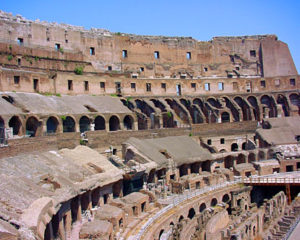The Roman theatre was never as popular as the other popular Roman entertainments (i.e. horse racing, gladiatorial matches, etc.) but Roman citizens did like it. To the average Roman citizen, life didn’t revolve around plays, but around religion.
Famous Roman Theatre and plays
Most plays were performed at festivals since many festivals were performed throughout the year, the Roman people became very familiar with various acting troupes, characters, plays, and playwrights. The Ancient Roman stage set the stage for our later theatre productions.

Ludi was a form of free entertainment at the expense of the State. They were divided into three categories:
- ludi Scaenici (Dramatic entertainment performed in a theater)
- munera Gladiatoria (Gladiatorial exhibitions performed in an amphitheater)
- ludi Cirenses (exhibitions in a circus, including chariot races)
Races and gladiatorial shows were more popular than the plays. Shows were regularly put on during the religious holidays. While the republic flourished, there were a total of 66 holidays per year. However, at the time of Marcus Aurelius, there were 135 holidays per year.
Roman Comedy Characteristics
Since Roman theaters had no lighting facilities, plays were given during daytime (originally, after the noon hour, but later, mostly in the morning). The average comedy required around two hours.
There were four kinds of dramatic performances:
- Comedies
- Tragedies
- Farces
- Pantomimes
The latter two were considered the most popular
Each performance group had a manager, who was in charge of the actors (most often slaves), and the troop’s customs. Most managers tried to have the least amount of actors possible; therefore, actors played many different characters within one play. One way to distinguish the characters was by their wigs: GREY wigs represented old men, black wigs represented young men and red represented the slaves.
Roman Masks
Roman Masks played an important part in Ancient Roman Plays and the Roman Theatre. An actor’s entire head was covered by his mask, which included his hair, so the Roman mask was quite large.

The design of the mask was quite simple and they were made from were made cheap materials such as linen or cork. They had big holes in the mouth and the eyes. The Roman masks, like the Greek masks that they emulated, were used for many reasons:
- The masks were large and portrayed exaggerated expressions which could be seen from the back of the theatre so the audience could tell how the character was feeling
- The Mask amplified the actor’s voice, making it possible to hear him everywhere in the theatre
- The mask easily conveyed emotions to the audience so they knew if a character was happy, sad, upset, tired, or scared
- The Tragic mask carried mournful or pained expressions
- Comic masks were smiling or leering. Over time the comedic masks became grotesquely exaggerated
- Masks allowed the actors to play multiple parts and roles. The masks could be personalized for each character
- Status and character were easily conveyed
- The masks were color-coded, brown for men and white for women




